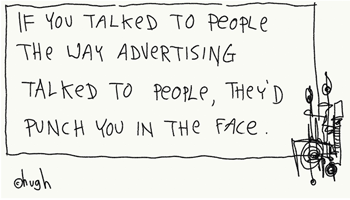 The immediacy, simplicity, and sheer addictiveness of Twitter has lulled many bloggers into letting their blogs lay fallow. But a look at blogs in the AdAge Power 150 will quickly confirm that lots of blogs, including this one, are still not only active, but growing our reach.
The immediacy, simplicity, and sheer addictiveness of Twitter has lulled many bloggers into letting their blogs lay fallow. But a look at blogs in the AdAge Power 150 will quickly confirm that lots of blogs, including this one, are still not only active, but growing our reach.
Dear ad agencies, when you ignore – or screw up – blog advertising, you are missing one of the Internet’s most cost-effective and potent opportunities. Other excellent conversational media opportunities are available too, but this post will address blog advertising because agencies just don’t seem to get it. As a result, clients are missing a great opportunity for two-way dialog.
In fact, you can often reach an influential and devoted niche audience of thousands for as little as $50 a week. So why are agencies and advertisers so wary?
(Before we continue, it’s necessary to note that the most important ingredients are always going to be a great product and great service. No amount of advertising, no matter how clever, or well-placed, can make up for a lousy product or its kissing cousin, lousy service.)
Let’s look at some myths and some facts about blog advertising.
Myth 1: There’s no way to measure blog advertising
Fact: 1 You get detailed real-time stats from blog advertising networks like Blogads.com, Federated Media and Blog Her
Myth 2: Bloggers might make fun of your ads.
Fact 2: True. But you might need better ads. (please see Dear NBC – Your Ad on My Blog Stinks: Let’s Fix It )
Myth 3: Blogs don’t have enough readers to matter in an ad campaign.
Fact 3: Would 50 million uniques a month work for you? Stellar numbers are no problem if you advertise on the right blogs, with the right ads.
Even a blog with 5,000 readers a week can be influential beyond measure if its readers are highly engaged.
Myth 4: One half of one percent is a great click thru result on the Internet.
Fact 4: Blog advertising that is appropriate, interesting and fun can easily hit .236 – 1.5% clickthrus. Campaigns I’ve done for clients have averaged 1.5% clickthru, and have hit as high as 3.5%.
As Blogads.com founder Henry Copeland has noted, “Some advertisers get 5% clickthrus, some get 0.01% on the same blog.”
The reason most ads get such lousy clickthru online is that they are wrong for the medium. You can’t scream at people, cover up the content they are trying to read (doh) or otherwise scam them and expect to put them in a buying mode. (Please see Fact 2)
Myth 5 – An ad that will pull in print or on a more traditional website will also pull on blog.
Fact 5 – You need to be edgy, clever, interesting, and speak in a voice actual humans would use.
Skip the hype and flash. Nobody is going to read a self-trumpeting blog or one that’s awash in obvious hype.
Related:
– Still Wary of Blog Advertising? Time to Take Another Look.
– Mainstream Publishers Forming Blog Advertising Networks – But Still Misunderstanding Blogs
– Blog Ads for Author Karen Quinn’s Contest Develop a Following








Thanks for debunking these and for the tips. No matter what, I always hear that people still believe #3 and even #5.
Is advertising that bad? LOL. The clip attached was funny.
“Some advertisers get 5% clickthrus, some get 0.01% on the same blog.”
–Probably it’s not just that it’s not right fir the site. It also might not look interesting enough. In most cases, people use their sense of sight more – and when something doesn’t look too pleasing to them, it will take a lot of convincing before they start caring about whatever it is you are advertising. So I guess the main solution here is to create something aesthetically acceptable, at the very least.
My experience has been, the bigger the company, the less likely they are to pay attention to the details like catering an ad to a particular audience. It’s the disadvantage of targeting the masses through niche’s. When they say that blog advertising doesn’t work, maybe what they’re really saying is that they didn’t take the time to create the right ad, so using the old methods of advertising didn’t work in a blog environment. Either way, it’s the agency #FAIL for not targeting the niche audience correctly.